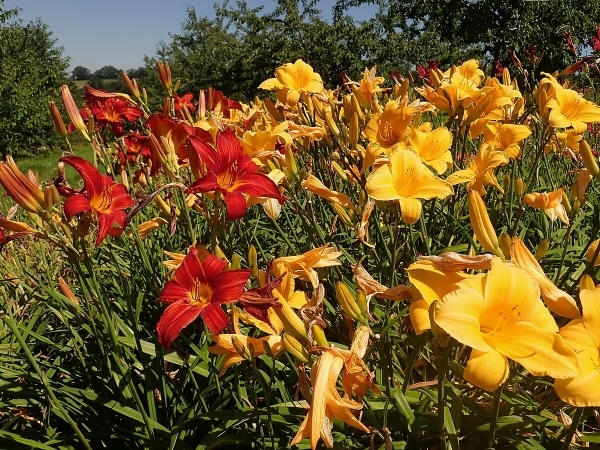
Daylily
Botanical Name
:
Hemerocallis spp.
Plant Type
:
Herbaceous perennial
Seasons
:
Plant in late spring or early fall; blooms in summer, with some varieties blooming in spring or fall, and some reblooming throughout the season
Sun Level
:
Full sun to partial shade;at least 6 hours of direct sun daily
Ideal Soil Temperature for Planting
:
Full sun to partial shade;at least 6 hours of direct sun daily
Soil Type
:
Well-drained; prefers lots of organic matter
Hardiness Zones
:
3–9 (USDA)
Germination
:
20–25 days
P.H. Level
:
6.0–7.0 (slightly acidic to neutral)
Water/Irrigation
:
Water regularly, especially during dry periods. Once established, they are drought-tolerant
Fertilization
:
Apply a balanced fertilizer (for example 10-10-10) in spring as new growth begins
Habit
:
Clumping, arching
Propagation
:
Seeds and division (in spring or fall)
Final Plant Height
:
1–4 ft
Spread
:
1–3 ft
Flowers
:
Large, lily-shaped flowers in a wide range of colors, including yellow, orange, red, pink, purple, and white
Attracts
:
Butterflies, bees, and hummingbirds
Uses
:
Ornamental (garden beds, borders, cut flowers), erosion control (on slopes)
Companions
:
Coneflowers (Echinacea), yarrow (Achillea), salvia, ornamental grasses
Pruning
:
Remove faded flower stalks after blooming. Cut back any dead or damaged foliage in late fall or early spring
Toxicity
:
Typically non-toxic to humans and pets
Pests
:
Aphids, spider mites, thrips, slugs, and snails
Diseases
:
Crown rot, leaf spots, and rust
Confused With
:
True lilies (Lilium spp.), although daylilies are not closely related to true lilies
Additional Info
:
The name “Hemerocallis” comes from the Greek words “hemera” (day) and “kallos” (beauty), referring to the fact that each flower lasts only one day. However, each plant produces many buds, so the blooming period can last for several weeks
Botanical Name
:
Hemerocallis spp.
Plant Type
:
Herbaceous perennial
Seasons
:
Plant in late spring or early fall; blooms in summer, with some varieties blooming in spring or fall, and some reblooming throughout the season
Sun Level
:
Full sun to partial shade;at least 6 hours of direct sun daily
Ideal Soil Temperature for Planting
:
Full sun to partial shade;at least 6 hours of direct sun daily
Soil Type
:
Well-drained; prefers lots of organic matter
Hardiness Zones
:
3–9 (USDA)
Germination
:
20–25 days
P.H. Level
:
6.0–7.0 (slightly acidic to neutral)
Water/Irrigation
:
Water regularly, especially during dry periods. Once established, they are drought-tolerant
Fertilization
:
Apply a balanced fertilizer (for example 10-10-10) in spring as new growth begins
Habit
:
Clumping, arching
Propagation
:
Seeds and division (in spring or fall)
Final Plant Height
:
1–4 ft
Spread
:
1–3 ft
Flowers
:
Large, lily-shaped flowers in a wide range of colors, including yellow, orange, red, pink, purple, and white
Attracts
:
Butterflies, bees, and hummingbirds
Uses
:
Ornamental (garden beds, borders, cut flowers), erosion control (on slopes)
Companions
:
Coneflowers (Echinacea), yarrow (Achillea), salvia, ornamental grasses
Pruning
:
Remove faded flower stalks after blooming. Cut back any dead or damaged foliage in late fall or early spring
Toxicity
:
Typically non-toxic to humans and pets
Pests
:
Aphids, spider mites, thrips, slugs, and snails
Diseases
:
Crown rot, leaf spots, and rust
Confused With
:
True lilies (Lilium spp.), although daylilies are not closely related to true lilies
Additional Info
:
The name “Hemerocallis” comes from the Greek words “hemera” (day) and “kallos” (beauty), referring to the fact that each flower lasts only one day. However, each plant produces many buds, so the blooming period can last for several weeks
Written by Nondiah Khalayi – https://www.linkedin.com/in/nondiah-khalayi/

